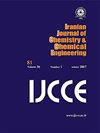零价金属和双金属存在下Cr(VI)污染土壤的还原修复
IF 1
4区 工程技术
Q4 CHEMISTRY, MULTIDISCIPLINARY
Iranian Journal of Chemistry & Chemical Engineering-international English Edition
Pub Date : 2021-06-22
DOI:10.30492/IJCCE.2021.135174.4293
引用次数: 0
摘要
研究了零价金属(Al0和Zn0)及其双金属(Fe/Al和Fe/Zn, 0.1 g壳金属g-1芯金属)在3种污染土壤(钙质、非钙质近中性和微酸性)中还原Cr(VI)的时效效率。用还原剂(0、5、10 g kg-1)对100、500 mg kg-1的Cr(VI)污染土壤进行处理,测定0.5、4、24、48、168 h后土壤中可交换性Cr(VI)的浓度。双金属颗粒的平均还原能力(11.4 mg Cr g-1)远高于zvm (3.3 mg Cr g-1)。zvm在几分钟内显示出快速钝化,而双金属颗粒甚至可以保持其反应性长达一小时。此外,zvm在微酸性土壤中的效率远高于其他两种土壤。铁/铝在钙质土壤中表现良好,危害潜力高于其他两种土壤。双金属颗粒在非钙质近中性土壤中的Cr(VI)还原能力是钙质土壤中的2倍。双金属的准一阶Cr(VI)还原速率常数(0.248 h-1)平均高于zvm (0.074 h-1)。本文章由计算机程序翻译,如有差异,请以英文原文为准。
Reductive remediation of Cr(VI)-contaminated soils in the presence of zero-valent metals and bimetals
The time-dependent efficiency of zero-valent metals (ZVMs) including Al0 and Zn0 and their bimetals (Fe/Al and Fe/Zn, 0.1 g shell metal g-1 core metal) to reduce Cr(VI) in three contaminated soils (calcareous, non-calcareous near neutral and slightly acidic) was studied. The Cr(VI)-contaminated soils (100 and 500 mg kg-1) were amended with the reductants (0, 5 and 10 g kg-1) and the concentration of exchangeable Cr(VI) was determined after 0.5, 4, 24, 48 and 168 hours. It was found that the average reducing capacity of the bimetallic particles (11.4 mg Cr g-1) was much higher than the ZVMs (3.3 mg Cr g-1). The ZVMs showed a rapid passivation within only a few minutes, while the bimetallic particles preserved their reactivity even up to one hour. In addition, the efficiency of ZVMs in the slightly acid soil was much higher than two other soils. There was a good performance of Fe/Al in the calcareous soil with a higher hazard potential than two other soils. The Cr(VI) reduction capacity of the bimetallic particles in non-calcareous near neutral soil was two times more than in calcareous soil. The pseudo-first order Cr(VI) reduction rate constants for the bimetals (0.248 h-1) was on average higher than those of the ZVMs (0.074 h-1).
求助全文
通过发布文献求助,成功后即可免费获取论文全文。
去求助
来源期刊

Iranian Journal of Chemistry & Chemical Engineering-international English Edition
CHEMISTRY, MULTIDISCIPLINARY-ENGINEERING, CHEMICAL
CiteScore
2.80
自引率
22.20%
发文量
0
审稿时长
6-12 weeks
期刊介绍:
The aim of the Iranian Journal of Chemistry and Chemical Engineering is to foster the growth of educational, scientific and Industrial Research activities among chemists and chemical engineers and to provide a medium for mutual communication and relations between Iranian academia and the industry on the one hand, and the world the scientific community on the other.
 求助内容:
求助内容: 应助结果提醒方式:
应助结果提醒方式:


